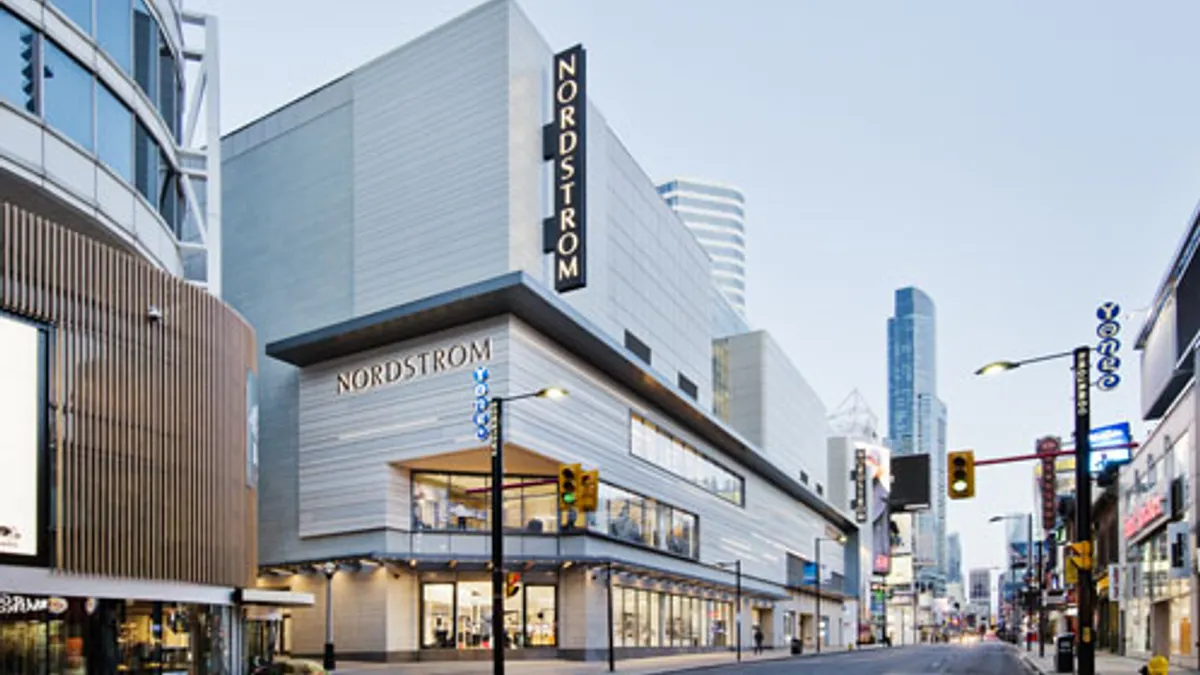Dive Brief:
-
Nordstrom on Wednesday reported that total second quarter net sales fell 5.1% year over year, with full-price net sales down 6.5% and off-price net sales down 1.9%. Total company digital sales increased 4% and were 30% of the business, according to a company press release.
-
The department store no longer reports store comps in light of the blurring of on- and offline sales channels. Inventory was down 6.5% over last year, which protected the bottom line and set merchandising up well for fall, the company said.
-
Net earnings in the quarter reached $141 million, down from $162 million in the year-ago quarter. Earnings before interest and taxes (EBIT) were $216 million, or 5.7% of net sales, compared with $246 million, or 6.2% a year ago, a decline "driven primarily by lower sales volume," per the release.
Dive Insight:
Nordstrom was rewarded in after-hours trading Wednesday afternoon as profits beat estimates, burnished with the promise of clean inventories.
The department store in its release said it's expanding its "Local" concept to New York City, its largest market for online sales, with two neighborhood hubs in September, along with the opening of a flagship store there on Oct. 24.
While the annual Anniversary Sale last month got off to a rocky start and miffed some loyalists, the company reported that the sale had "year-over-year improvements in customer metrics" and that its new Nordy Club loyalty setup has grown 12% year over year, ending the quarter with 12 million active customers, and represents 64% of sales.
But even that program has "a huge amount of untapped potential," according to Ya-Bing Chu, vice president of product at loyalty platform Formation, because it doesn't appear to "leverage customer engagement data to maximize each location’s comparables," he told Retail Dive in emailed comments. "To account for ever more divergent interests and preferences, loyalty programs can be used to incentivize customers to share their preferences, pre-order merchandise, and give detailed feedback on a wide array of experimental offerings. This is a break from how static tiers have traditionally only told one story."
That could address other analyst concerns. "Unfortunately, Nordstrom has not been able to properly localize its offer to generate better trading," GlobalData Retail Managing Director Neil Saunders said in a note emailed to Retail Dive.
Its Rack sales performance, which has consistently outshone that of full-line stores, was a let-down in light of the 7% revenue increase in the year-ago quarter and of the off-price model's health in general. "[T]he continued slump in both parts of the business now raises some serious questions about Nordstrom’s strategy and suggests that problems run far deeper than the missteps in the loyalty program which the company blamed for last quarter’s poor outcome," Saunders warned, adding that a fragmented, less compelling product mix is to blame. "We also think that the lack of a homewares offering leaves Rack much more exposed to the vagaries of the apparel market, which is unhelpful compared to rivals like TJMaxx and even Macy’s Backstage."
He also called the decision to withhold store comps "telling." While the company itself may not post that data, GlobalData Retail crunched some alarming numbers in that metric. For Nordstrom's physical stores, GlobalData estimates full-line comparable sales fell by high-single digits and off-price comps by mid-single digits. "These are dire numbers and completely undermine Nordstrom’s assertion that it is engineering better productivity," Saunders said.
Nordstrom hasn't had to grapple with an overblown footprint, unlike Macy's, which has closed 100 or so stores in recent years. But it nevertheless has too many locations in substandard malls, according to Saunders.
"Put bluntly, these are not locations where Nordstrom would open stores today because the demographics and demand profile within the trade area has become increasingly unsuited to what Nordstrom has to offer," he said, adding, however, that "the problems do not stop at weaker stores" in part because e-commerce is cannibalizing stores, preventing impulse purchases, but also because merchandising is falling flat.
While leaner inventory will allow the retailer some freedom in merchandising, it's a stiff challenge considering how consumers these days seemingly have less need for apparel. UBS analysts last month deemed the department store a "no-growth retailer," citing trends for less expensive and more casual attire. Saunders questioned whether Nordstrom is up to it.
"Companies do go through periods of weak performance and Nordstrom is no exception," Saunders said Wednesday. "However, one of our forward concerns is management’s slightly blasé attitude to the poor results both this quarter and last. There are clearly problems within the business and before it can fix them Nordstrom needs to own them."
The department store retailer lowered its guidance, saying that revenues are likely to fall 2%, compared to its earlier expectation of a 2% decrease to flat, and that per-share earnings would reach $3.25 to $3.50, topping lower than its previous expectation for $3.25 to $3.65.















